
(a)
Interpretation:
The most likely site(s) of electrophilic
Concept introduction:
Electrophilic aromatic substitution reaction rate increases with increase in electron density around the ring. The electron donating groups activates whereas the electron withdrawing groups deactivates the aromatic ring. The electron donating groups increases the electron density at ortho-para position and thus they are ortho-para directing. The electron withdrawing groups decrease electron density at ortho/para and has comparatively greater electron density at meta position, thus they are meta directing.
Answer to Problem 23.53P
The most likely site(s) electrophilic aromatic substitution in the given molecule is:
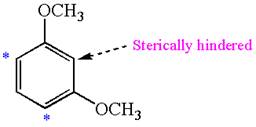
Explanation of Solution
The given molecule is:
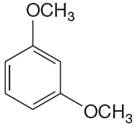
In the given molecule, benzene has two methoxy substituents. These are activating groups, thus ortho-para directors. Each methoxy group activates their two ortho and one para positions. The activated sites are same for both groups, thus overall there are three activated sites. But the position between two methoxy groups is sterically hindered. Thus, the molecules have only two possible sites of electrophilic aromatic substitution which are indicated by an asterisk
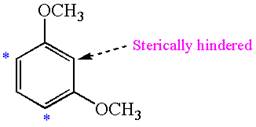
The most likely site(s) of electrophilic aromatic substitution are determined by identifying positions activated by the substituents attached.
(b)
Interpretation:
The most likely site(s) of electrophilic aromatic substitution in the given molecule are to be indicated.
Concept introduction:
Electrophilic aromatic substitution reaction rate increases with increase in electron density around the ring. The electron donating groups activate whereas the electron withdrawing groups deactivate the aromatic ring. The electron donating groups increase the electron density at ortho-para position and thus they are ortho-para directing. The electron withdrawing groups decreases electron density at ortho/para and has comparatively greater electron density at meta position, thus they are meta directing.
Answer to Problem 23.53P
The most likely site(s) of electrophilic aromatic substitution in the given molecule are:
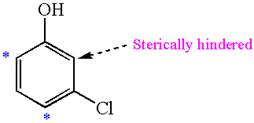
Explanation of Solution
The given molecule is:
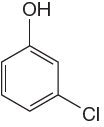
In the given molecule, benzene has one hydroxyl and one chloride substituent. Both these are activating groups, thus ortho-para directors. Each of the susbtituents activates their two ortho and one para positions. The activated sites are same for both groups thus overall there are three activated sites. But the position between these two substituents is sterically hindered. Thus, molecules have only two possible sites of electrophilic aromatic substitution which are indicated by an asterisk
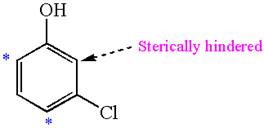
The most likely site(s) of electrophilic aromatic substitution are determined by identifying positions activated by the substituents attached.
(c)
Interpretation:
The most likely site(s) of electrophilic aromatic substitution in the given molecule are to be indicated.
Concept introduction:
The electrophilic aromatic substitution reaction rate increases with increase in electron density around the ring. The electron donating groups activates whereas the electron withdrawing groups deactivates the aromatic ring. The electron donating groups increase the electron density at ortho-para position and thus they are ortho-para directing. The electron withdrawing groups decrease electron density at ortho/para and have comparatively greater electron density at meta position, thus they are meta directing.
Answer to Problem 23.53P
The most likely site(s) of electrophilic aromatic substitution in the given molecule are:
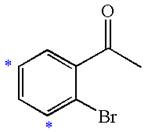
Explanation of Solution
The given molecule is:
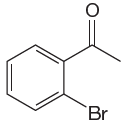
In the given molecule, benzene has one acetyl and one bromide substituent. Acetyl is carbonyl group which is deactivating thus it is meta director. The bromine atom is activating group thus it is ortho/para director. The acetyl group activates its two meta positions and bromine activates its one ortho and one para positions. The meta positions of acetyl group are same as the ortho/para position of bromine atom. Thus the molecules have only two possible sites of electrophilic aromatic substitution which are indicated by an asterisk
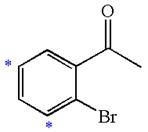
The most likely site(s) of electrophilic aromatic substitution are determined by identifying positions activated by the substituents attached.
(d)
Interpretation:
The most likely site(s) of electrophilic aromatic substitution in the given molecule are to be indicated.
Concept introduction:
The electrophilic aromatic substitution reaction rate increases with increase in electron density around the ring. The electron donating groups activates whereas the electron withdrawing groups deactivates the aromatic ring. The electron donating groups increases the electron density at ortho-para position and thus they are ortho-para directing. The electron withdrawing groups decreases electron density at ortho/para and has comparatively greater electron density at meta position, thus they are meta directing.
Answer to Problem 23.53P
The most likely site(s) of electrophilic aromatic substitution in the given molecule are:
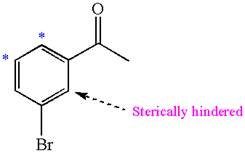
Explanation of Solution
The given molecule is:
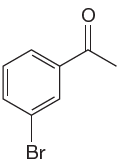
In the given molecule, benzene has one acetyl and one bromide substituent. Acetyl is carbonyl group which is deactivating thus it is meta director. The bromine atom is activating group thus it is ortho/para director.
The acetyl group activates its one meta positions and bromine activates two ortho and one para positions. The activating sites of both groups are different, thus overall there are three activated sites. But the position between these two substituents is sterically hindered. Thus, molecules have only two possible sites of electrophilic aromatic substitution which are indicated by an asterisk

The most likely site(s) of electrophilic aromatic substitution are determined by identifying positions activated by the substituents attached.
(e)
Interpretation:
The most likely site(s) of electrophilic aromatic substitution in the given molecule are to be indicated.
Concept introduction:
The electrophilic aromatic substitution reaction rate increases with increase in electron density around the ring. The electron donating groups activates whereas the electron withdrawing groups deactivates the aromatic ring. The electron donating groups increases the electron density at ortho-para position and thus they are ortho-para directing. The electron withdrawing groups decreases electron density at ortho/para and has comparatively greater electron density at meta position, thus they are meta directing.
Answer to Problem 23.53P
The most likely site(s) of electrophilic aromatic substitution in the given molecule are:

Explanation of Solution
The given molecule is:

In the given molecule, benzene has one nitro and one methyl substituent. Nitro group is deactivating thus it is meta director. The methyl group is activating group thus it is ortho/para director. The nitro group activates its two meta positions and methyl group activates its one ortho and one para positions. The meta positions of nitro group are same as the ortho/para positions of methyl groups. Thus, the molecules have only two possible sites of electrophilic aromatic substitution which are indicated by an asterisk

The most likely site(s) of electrophilic aromatic substitution are determined by identifying positions activated by the substituents attached.
(f)
Interpretation:
The most likely site(s) of electrophilic aromatic substitution in the given molecule are to be indicated.
Concept introduction:
The electrophilic aromatic substitution reaction rate increases with increase in electron density around the ring. The electron donating groups activates whereas the electron withdrawing groups deactivates the aromatic ring. The electron donating groups increases the electron density at ortho-para position and thus they are ortho-para directing. The electron withdrawing groups decreases electron density at ortho/para and has comparatively greater electron density at meta position, thus they are meta directing.
Answer to Problem 23.53P
The most likely site(s) of electrophilic aromatic substitution in the given molecule are:
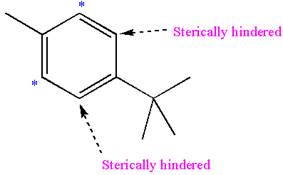
Explanation of Solution
The given molecule is:
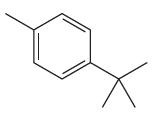
In the given molecule, benzene has one methyl and one

The most likely site(s) of electrophilic aromatic substitution are determined by identifying positions activated by the substituents attached.
(g)
Interpretation:
The most likely site(s) of electrophilic aromatic substitution in the given molecule are to be indicated.
Concept introduction:
The electrophilic aromatic substitution reaction rate increases with increase in electron density around the ring. The electron donating groups activates whereas the electron withdrawing groups deactivates the aromatic ring. The electron donating groups increases the electron density at ortho-para position and thus they are ortho-para directing. The electron withdrawing groups decreases electron density at ortho/para and has comparatively greater electron density at meta position, thus they are meta directing.
Answer to Problem 23.53P
The most likely site(s) of electrophilic aromatic substitution in the given molecule are:

Explanation of Solution
The given molecule is:

In the given molecule, benzene has one methyl and one amino substituent. They both are activating groups, thus they are ortho/para positions. Each of the susbtituents activates their two ortho and one para positions. The some activated sites are not same for both groups so, overall there are three activated sites. But the position between two groups is sterically hindered. Thus, molecules have only two possible sites of electrophilic aromatic substitution which are indicated by an asterisk

The most likely site(s) of electrophilic aromatic substitution are determined by identifying positions activated by the substituents attached.
Want to see more full solutions like this?
Chapter 23 Solutions
EBK ORGANIC CHEMISTRY: PRINCIPLES AND M
- The emission data in cps displayed in Table 1 is reported to two decimal places by the chemist. However, the instrument output is shown in Table 2. Table 2. Iron emission from ICP-AES Sample Blank Standard Emission, cps 579.503252562 9308340.13122 Unknown Sample 343.232365741 Did the chemist make the correct choice in how they choose to display the data up in Table 1? Choose the best explanation from the choices below. No. Since the instrument calculates 12 digits for all values, they should all be kept and not truncated. Doing so would eliminate significant information. No. Since the instrument calculates 5 decimal places for the standard, all of the values should be limited to the same number. The other decimal places are not significant for the blank and unknown sample. Yes. The way Saman made the standards was limited by the 250-mL volumetric flask. This glassware can report values to 2 decimal places, and this establishes our number of significant figures. Yes. Instrumental data…arrow_forwardSteps and explanation pleasearrow_forwardSteps and explanation to undertand concepts.arrow_forward
- Nonearrow_forward7. Draw a curved arrow mechanism for the following reaction. HO cat. HCI OH in dioxane with 4A molecular sievesarrow_forwardTry: Convert the given 3D perspective structure to Newman projection about C2 - C3 bond (C2 carbon in the front). Also, show Newman projection of other possible staggered conformers and circle the most stable conformation. Use the template shown. F H3C Br Harrow_forward
- Nonearrow_forward16. Consider the probability distribution p(x) = ax", 0 ≤ x ≤ 1 for a positive integer n. A. Derive an expression for the constant a, to normalize p(x). B. Compute the average (x) as a function of n. C. Compute σ2 = (x²) - (x)², the variance of x, as a function of n.arrow_forward451. Use the diffusion model from lecture that showed the likelihood of mixing occurring in a lattice model with eight lattice sites: Case Left Right A B C Permeable Barrier → and show that with 2V lattice sites on each side of the permeable barrier and a total of 2V white particles and 2V black particles, that perfect de-mixing (all one color on each side of the barrier) becomes increasingly unlikely as V increases.arrow_forward
 ChemistryChemistryISBN:9781305957404Author:Steven S. Zumdahl, Susan A. Zumdahl, Donald J. DeCostePublisher:Cengage Learning
ChemistryChemistryISBN:9781305957404Author:Steven S. Zumdahl, Susan A. Zumdahl, Donald J. DeCostePublisher:Cengage Learning ChemistryChemistryISBN:9781259911156Author:Raymond Chang Dr., Jason Overby ProfessorPublisher:McGraw-Hill Education
ChemistryChemistryISBN:9781259911156Author:Raymond Chang Dr., Jason Overby ProfessorPublisher:McGraw-Hill Education Principles of Instrumental AnalysisChemistryISBN:9781305577213Author:Douglas A. Skoog, F. James Holler, Stanley R. CrouchPublisher:Cengage Learning
Principles of Instrumental AnalysisChemistryISBN:9781305577213Author:Douglas A. Skoog, F. James Holler, Stanley R. CrouchPublisher:Cengage Learning Organic ChemistryChemistryISBN:9780078021558Author:Janice Gorzynski Smith Dr.Publisher:McGraw-Hill Education
Organic ChemistryChemistryISBN:9780078021558Author:Janice Gorzynski Smith Dr.Publisher:McGraw-Hill Education Chemistry: Principles and ReactionsChemistryISBN:9781305079373Author:William L. Masterton, Cecile N. HurleyPublisher:Cengage Learning
Chemistry: Principles and ReactionsChemistryISBN:9781305079373Author:William L. Masterton, Cecile N. HurleyPublisher:Cengage Learning Elementary Principles of Chemical Processes, Bind...ChemistryISBN:9781118431221Author:Richard M. Felder, Ronald W. Rousseau, Lisa G. BullardPublisher:WILEY
Elementary Principles of Chemical Processes, Bind...ChemistryISBN:9781118431221Author:Richard M. Felder, Ronald W. Rousseau, Lisa G. BullardPublisher:WILEY





